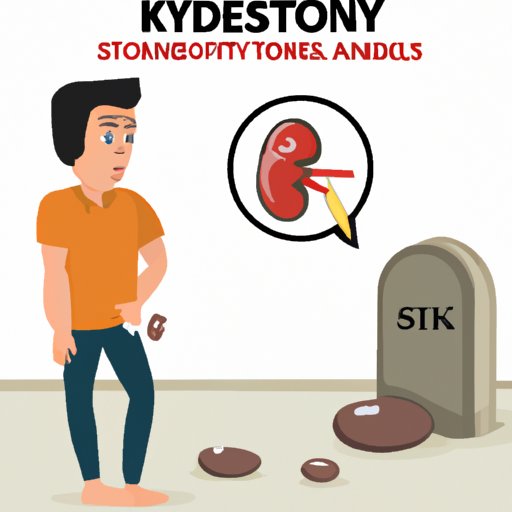
I. Introduction
Kidney stones are hard deposits that form in the kidneys and can range in size from specks of sand to the size of a grapefruit. Passing a kidney stone can be incredibly painful, and it is essential to know the signs and symptoms to seek medical attention. This article will explore the symptoms of passing a kidney stone, diagnostic techniques, prevention tips, medical intervention options, lifestyle changes, and aftercare.
II. Symptoms of Passing a Kidney Stone
The symptoms of passing a kidney stone can vary from person to person, and some individuals may not experience any symptoms at all. However, the most common symptoms include:
- Abdominal pain and discomfort: Individuals may experience sharp, severe pain that can radiate from the lower back to the groin area. The pain may come and go in waves and can vary in intensity.
- Painful urination: Pain or burning during urination can also be a symptom of passing a kidney stone.
- Frequent urination: Individuals may feel the urge to urinate more frequently than usual, even if only a small amount of urine is produced each time.
- Nausea and vomiting: Nausea and vomiting can be the result of severe pain.
- Fever and chills: Fever and chills can be a sign of an infection, which can occur if a kidney stone causes a blockage in the urinary tract.
If you experience any of these symptoms, it’s essential to seek medical attention immediately
III. Diagnostic Techniques
Diagnostic techniques used to identify kidney stones include:
- Urine Analysis: A urine test can detect the presence of blood, white blood cells, and minerals that can contribute to the formation of kidney stones.
- CT Scan: A CT scan can create detailed images of the urinary tract, making it easier for doctors to identify the size, location, and type of kidney stone present.
- Ultrasound: An ultrasound can also be used to create images of the urinary tract and can help doctors identify kidney stones.
Your doctor will use a combination of these tests to diagnose kidney stones accurately.
IV. Prevention Tips
There are several measures you can take to prevent kidney stones from forming, including:
- Staying Hydrated: Drinking plenty of water can help dilute minerals and prevent them from crystallizing and forming kidney stones.
- Maintaining a Low Oxalate Diet: Some foods are high in oxalate and can contribute to the formation of kidney stones. It is essential to avoid or limit foods such as spinach, beets, and chocolate, and tea.
- Regular Exercise: Regular exercise can help reduce the risk of kidney stones by aiding the passage of urine through the urinary tract.
By adopting these preventative measures, you can significantly reduce your risk of developing kidney stones.
V. Medical Intervention
Medical intervention is necessary when kidney stones do not pass naturally or are causing significant pain. The types of medical intervention options available include:
- Medication: Medications are often prescribed to help relieve the symptoms of kidney stones, such as pain and nausea.
- Surgery: Surgery may be necessary to remove larger kidney stones that cannot pass on their own.
- Lithotripsy: Lithotripsy is a procedure that uses shock waves to break up kidney stones, allowing them to pass more easily.
Your doctor will recommend the best course of action for your situation based on the size, location, and type of kidney stone present.
VI. Lifestyle Changes
Lifestyle changes can help to reduce the risk of developing kidney stones. These changes may include:
- Dietary Changes: Avoiding high oxalate foods and increasing intake of calcium and magnesium-rich foods may help to prevent kidney stones.
- Exercise: Regular exercise can help to reduce the risk of kidney stones by aiding in the passage of urine through the urinary tract.
By adopting these lifestyle changes, you can significantly reduce your risk of developing kidney stones.
VII. Aftercare
It’s essential to follow aftercare instructions provided by your doctor to prevent the development of additional kidney stones. Aftercare instructions may include:
- Drinking plenty of water: Drinking water helps to flush out the urinary tract and prevent minerals from forming into kidney stones.
- Limiting salt intake: High salt consumption can increase the risk of kidney stones, so it’s important to limit salt intake.
- Follow-up appointments: Regular follow-up appointments can help your doctor monitor your condition and prevent the formation of additional kidney stones.
VIII. Conclusion
Passing a kidney stone can be an incredibly painful experience, but there are several ways you can prevent them from forming. By staying hydrated, maintaining a low oxalate diet, and getting regular exercise, you can reduce your risk of developing kidney stones. If medical intervention is required, several options, including medication, surgery, and lithotripsy, are available. Remember to follow your doctor’s aftercare instructions to prevent the development of additional kidney stones and maintain your overall health.
Don’t ignore the signs and symptoms of kidney stones. Seek medical attention immediately for proper diagnosis and treatment.





